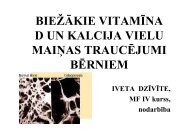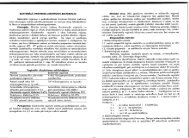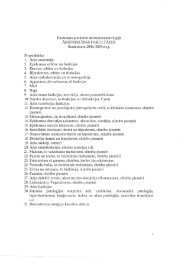PHYSICS
n - susliks.lv
n - susliks.lv
- No tags were found...
Create successful ePaper yourself
Turn your PDF publications into a flip-book with our unique Google optimized e-Paper software.
(J..), polarization (P), duration, frequency of light pulses, etc. Similar<br />
to movement parameters, light parameters may be divided<br />
into intensity which is characterized by absolute magnitude (I),<br />
gradient in space (dl/dx), and time (dI/dt).<br />
23.3.6. Photosensitization<br />
Photosensitization is increased sensitivity (hypersensitivity) of<br />
living organisms to light due to photochemical reactions induced<br />
loy different chemical substances (photosensitizers). This phenomenon<br />
has been a problem of economic importance in livestock in<br />
various parts of the world for hundreds of years. For example,<br />
Arabs in Tunis painted white horses with henna as protection<br />
against hypericism - a disease resulting from infection by several<br />
species of Hypericium that is facilitated by excessive sunlight. How<br />
light exerted its effect was not known until O. Raab (Munich,<br />
1900) observed that the killing of paramecia by a low concentration<br />
of acridines was greatly hastened by exposure to bright<br />
light. We now know that the general mechanism of photosensitization<br />
is related to the formation of highly reactive species<br />
(e.g., free radicals or singlet oxygen) that can lead to damage<br />
and in some instances death.<br />
The critical factor in animals that modulates photosensitization<br />
is the sensitivity of lightly pigmented skin to sunlight<br />
(e.g., in sheep the most susceptible sites are the ears, eyelids,<br />
face, lips and coronets; in cows the teats, udder and escutcheon).<br />
The first signs of photosensitization are often restlessness, exhibited<br />
as shaking of the head and ears, rubbing or scratching of<br />
the affected parts, and seeking of relief in the shade. In more<br />
severe cases, erythema is soon apparent and oedema develops<br />
rapidly. If the photosensitization is particularly severe, the animal<br />
may become comatose and die within a few hours.<br />
Diseases such as hypericism and fagopyrism, in which the photosensitizers<br />
are plant pigments, are the oldest known examples of<br />
photosensitization in domestic animals - sheep, cattle, goats,<br />
pigs and horses. Hypericism results from ingestion of Hyperiicum<br />
perforatum and fagopyrism is induced by buckwheat, Fagopyrum<br />
esculentum. Photosensitization of animals eating Tribulus terrestris<br />
and Sisymbrium altissimum has also been recognized for some time.<br />
174<br />
23.4. EFFECT OF NEAR-INFRARED RADIATION<br />
ON LIVING ORGANISMS<br />
Visible and near-infrared radiation (400 to 2500 nm) is<br />
important in medical applications; the longer the wavelengths in<br />
the visible part of the spectrum, the deeper the penetration of<br />
the radiation into the skin (fig. 23.2). There are many chromo-<br />
Ultraviolet Visisble Infrared<br />
,<br />
region , region region<br />
200 400 500 :800 1000 1200 nm<br />
" '<br />
,<br />
• 0 ~. ·n '<br />
Dermis~ c<br />
(JO<br />
Epidermis<br />
..........~.. ~<br />
" Ii<br />
... .<br />
• Subcutaneous • 4 • •• • •• l • • • • • •<br />
• • • tisse·· • • • • • • • • • • • • • • • • •<br />
Fig. 23.2. Penetration of light into light-colored human skin<br />
phores in skin and blood: (e.g., proteins, amino acids, DNA,<br />
RNA, hemoglobin, bilirubin, melanin). Two primary spectroscopic<br />
phenomena partici pate in the interaction of infrared radiation<br />
with human tissue - light scattering in the region of 1.52 <br />
1.85 urn and molecular absorption (e.g., by water, fat, and protein)<br />
in the 2.0 - 2.5 urn region. Tissue to be treated must be<br />
thick enough to provide absorption of NIR radiation by glucose<br />
but thin enough to allow sufficient NIR energy to pass through.<br />
Water, hemoglobin (the pigment that renders blood red), and<br />
melanin (the pigment that gives skin its color) present in human<br />
surface tissue, exert a significant affect on the absorption of<br />
optical radiation. The spectral range within the "therapeutic<br />
window" (fig. 23.3) is between 600 and 1300 nm due to absorption<br />
by water and pigments.<br />
175






